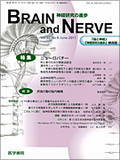Japanese
English
- 有料閲覧
- Abstract 文献概要
- 1ページ目 Look Inside
- 参考文献 Reference
はじめに
神経系はimmunologically priviledged siteとされ,全身の免疫現象からは隔絶された部位であると長らく認識されてきた。この考え方は,基本的に中枢神経系は①実質内にMHC(major histocompatibility complex)クラスⅠ,Ⅱを発現する細胞がない,すなわち,T細胞が抗原を認識するのに必要な細胞がない,②中枢神経系に移植された同種異型グラフトまたは異種グラフトは,中枢神経外に移植されたものと比べてはるかに拒絶反応が少ない,③免疫系の求心路であるリンパ管が存在しない,といったことに加えて,④中枢神経系への免疫系の遠心路は,血液脳関門(blood-brain barrier:BBB)と血液脳脊髄液関門(blood-cerebrospinal fluid barrier:BCSFB)によってシャットダウンされている,という4つの事実に基づく。現在,この“immunologically priviledged site”という考え方に数々の批判が加えられているのは周知の通りであるが,神経系が強固なバリアシステムで保護・コントロールされているということに関しては異論がない。神経系のバリアシステムには,このBBB,BCSFBに加えて血液網膜関門(blood-retinal barrier:BRB),血液脊髄関門(blood-spinal cord barrier),血液迷路関門(blood-labyrinth barrier)などが含まれ,blood-neural barrierと総称される。本論文の主題である血液神経関門(blood-nerve barrier:BNB)は,末梢神経系に存在するblood-neural barrierの1つである。
BNBはかつてはBBBと比較して不完全な構造物と考えられていた。しかし,現在では,末梢神経系を全身循環系から隔絶するBBBとほぼ同等の機能を持つ強固なバリアシステムと認識されており1),上記①~③の特徴はそのまま末梢神経系にも共通であることが知られている。BNBをヒトの疾患という側面からみた場合,BNBの破綻と修復が,例えば免疫性ニューロパチーの発症・増悪・治癒過程と密接に関連していることについては大きな異論はないであろう。しかし,BNBの分子機構に関する研究成果は驚くほど少ない。BBBに関する知見がこの10年間で飛躍的に蓄積しているのに対し,BNBはBBBとの比較のうえで語られることが多く,マクロ的にもミクロ的にもBNB研究はBBBのそれのはるか後塵を拝しているのが現状である。
本稿では,まず現時点でのBNBの解剖学的・細胞学的知見の概要を整理し,続いて現時点で明らかになっているバリアシステム破綻のメカニズムについて概説することとする。前述したように現時点ではBNB固有の知見は極めて少なく,多くはBBBまたは一般臓器の微小血管をもとにした研究で得られた成果であることを最初にお断りしておく。また,BNBという用語からは,常にめまぐるしく変化している血液成分から末梢神経系実質を隔てる“壁”としてのイメージがつきまとうが,実際には,BNBは単なる障壁ではなく,末梢神経系に必要なものを能動的に取り込み,不要物を積極的に排出する機能もあわせ持つ優れたインターフェースである。このことから,BNBよりもBNI(blood-nerve interface)という用語がより適切であると主張する研究者も存在する2)。筆者はこの考え方に基本的には賛成であるが,BBBという用語が既に定着している今,BNIという言葉を末梢神経系のバリアにのみ使用するのはいたずらに混乱を招くだけであるので,本稿ではBNBという形で記載を進める。またもう1つ,『神経学用語集』ではendoneuriumに対して神経内鞘という用語が採用されているが,本稿では神経実質を囲む鞘状構造物との混同を避けるため,従来の“神経内膜”をendoneuriumの訳語として使用することもあわせてお断りしておく。
Abstract
The blood-nerve barrier (BNB) is a dynamic interface between the endoneurial microenvironment and surrounding extracellular space or blood contents,and is localized the innermost layer of multilayered ensheathing perineurium and endoneurial microvessels. Since the BNB is a key structure controlling the internal milieu of the peripheral nerve parenchyma,adequate understanding of the BNB is crucial for developing treatment strategies for human peripheral nervous system disorders,including Guillain-Barré syndrome,chronic inflammatory demyelinating polyneuropathy,and diabetic and various metabolic/toxic neuropathies. However,fewer studies have been conducted on the BNB,if we compare against the number of studies on the blood-brain barrier. This is because of the lack of adequate human cell lines originating from the BNB. In our laboratory,human immortal cell lines from the BNB,namely,the endothelial cell line and pericyte cell line,have recently been established and vigorous investigations of their biological and physiological properties are now underway. Pericytes constituting the BNB were found to possess robust ability of controlling BNB integrity via secretion of various cytokines and growth factors including bFGF,VEGF,GDNF,BDNF,and angiopoietin-1. Unknown soluble factors secreted by pericytes also contribute to the upregulation of claudin-5 in endothelial cells in the BNB and thus,strengthen the barrier function of the BNB. In diabetic neuropathy,pericytes were shown to regulate the vascular basement membrane,while AGEs were shown to induce basement membrane hypertrophy and disrupt the BNB by increasing the autocrine secretion of VEGF and TGF-beta from pericytes. In this review article,we discuss the macroscopic and microscopic anatomy of the human BNB as well as the molecular mechanisms of mononuclear cell infiltration across the BNB.

Copyright © 2011, Igaku-Shoin Ltd. All rights reserved.


